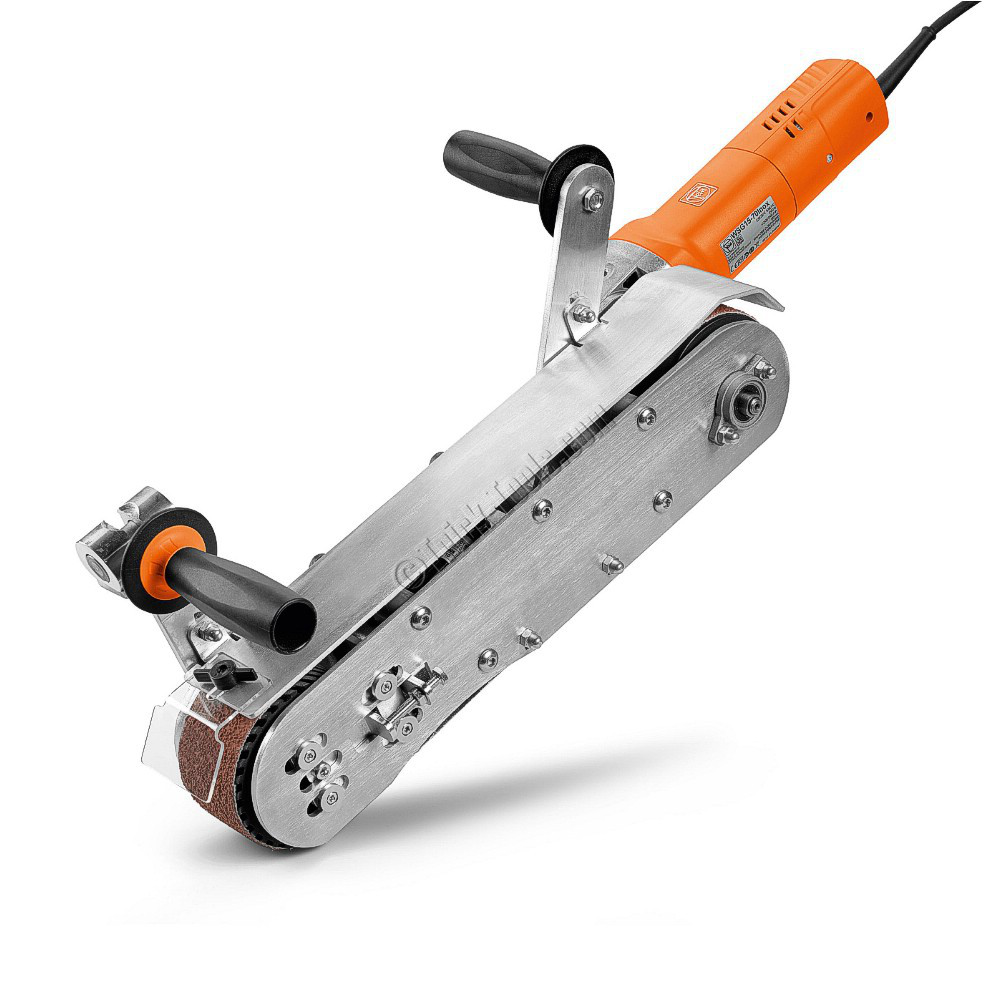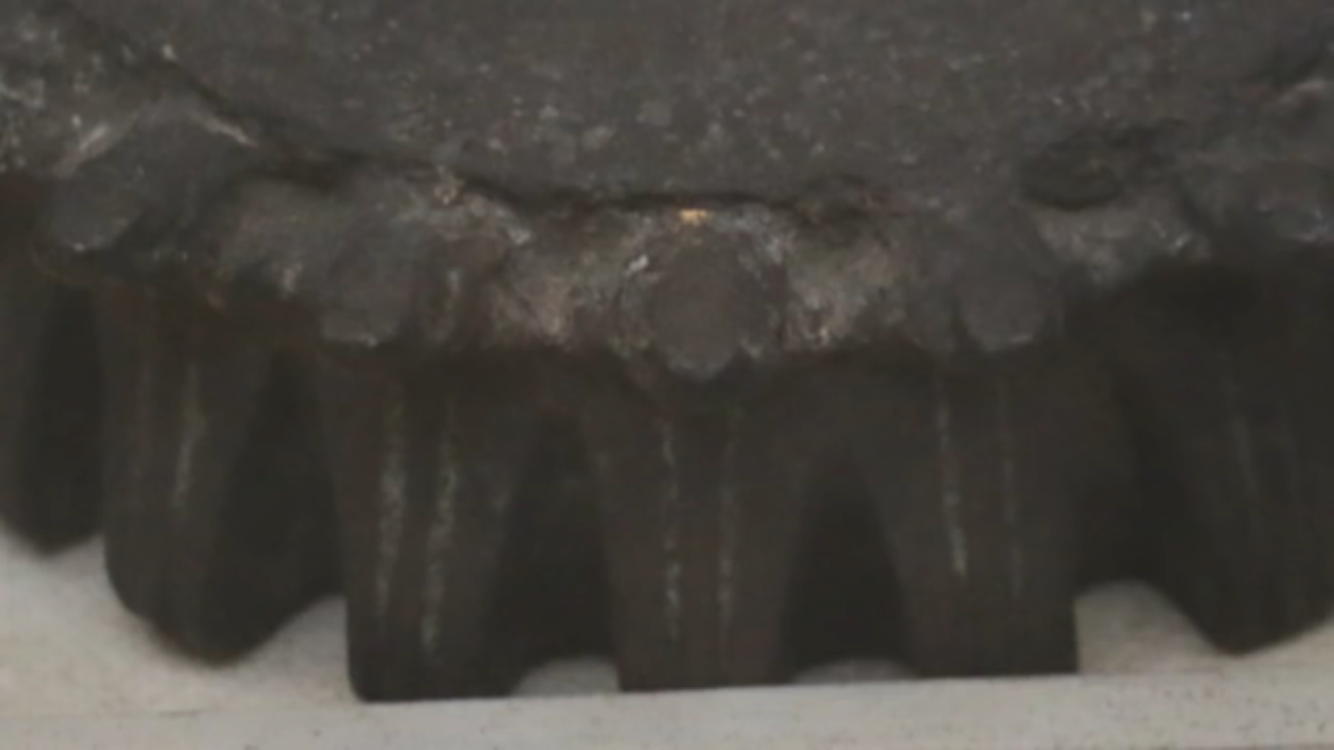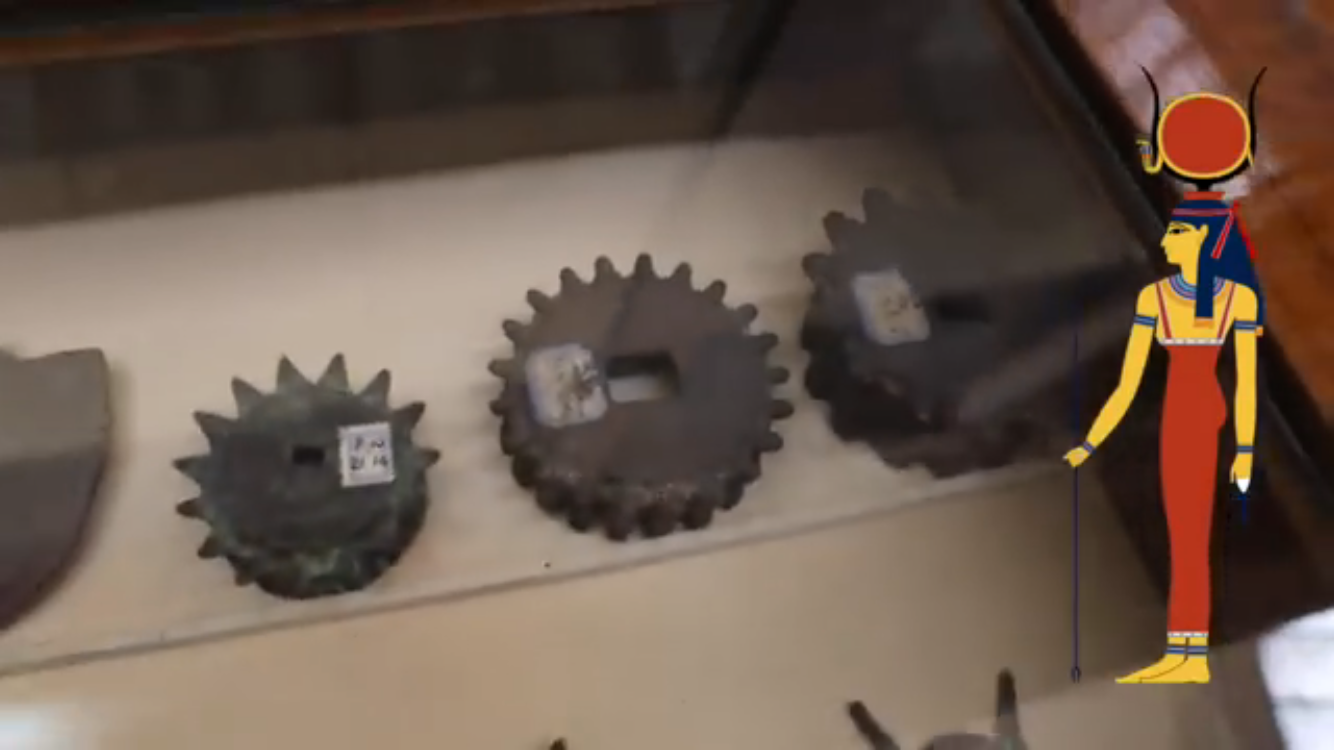It looks like you're using an Ad Blocker.
Please white-list or disable AboveTopSecret.com in your ad-blocking tool.
Thank you.
Some features of ATS will be disabled while you continue to use an ad-blocker.
share:
originally posted by: bluesfreak
I can’t quite seem to see how the stone workers would get their arms between these blocks to ‘pound’ them out? And these at Giza aren’t even granite. How would you get the leverage for a good ‘pound’ between these blocks ?
a reply to: Harte
Why would you need any space if cutting them out? You might want to get an idea of the scale here. I've been to that quarry in the early 80's and don't recall what the size of those 'lanes' were.
Something odd struck me about that one image. That nice piece of curved granite sitting on four rocks out in a place with no other granite is, no other rubble actually. It struck me as a manufactured (pun intended) set up. I was just wondering if any of those same stones were found there or if that pieces was trucked in?
originally posted by: Phage
a reply to: Hanslune
I think the problem is room to swing.
But then, if you're pounding down, there's plenty of room. I think.
When I've done that sort of pounding I did it up and down, 'heaving' right and left as would have been necessary at one of the Rapa Nui statues as it neared finishing would have been awful stressful.
Hey Phage take a look at the photo'd (in the post dated 16:01 does that piece seem like it belongs there?
originally posted by: bluesfreak
Surely if the sand was “free to roam” throughout the cutting process, then we would see a far rougher looking cut with abrasive scratchy striations al over it, and certainly inbetween the feed rate evidence we see here.
And yet the striations on cores and slabs cut out in Stock's experiments are no different than those left by the AEs. And, given that every AE cut is "V" shaped, it's very clear that abrasion along the walls of the cut continues even as the saw blade plunges, otherwise the cuts would have parallel sides.
That abrasion masks any grooves used to calculate feed rate to the point that Dunn's claim there is just speculation.
originally posted by: bluesfreak There are no AE artwork of these objects but yet the evidence is there. Perhaps that’s why there were more of the stone boxes like on Elephantine Island, because they had the sawing capability to ‘knock them out’ as we say.
I’d really like to examine that stone of Dunn’s at Abu Ghirab and look at the striations it’s a fascinating piece to me.
This cut looks too clean on the surface to have had abrasives flying about between the blade and material.
How are you so sure you are not looking at feed rate?
In the machining world, these striations indicate a ‘power feed’ fingerprint. They are VERY regular, perhaps too regular for two guys with a copper saw and sand taking an absolute age at 3mm per day to hack through the piece.
They could surely have spun a circular blade at high rpm, the AE had gears didn’t they?
Cairo Museum :
a reply to: Harte
IIRC, those "gears" are from a much later age. It's just that con men like to say differently.
Edit: Did you have a close look at the striations on the "curved" cut you posted? Do they not seem straight up and down to you and not curving with the edge of the cut? They do to me.
Harte
edit on 11/18/2018 by Harte because: of the wonderful things he does!
originally posted by: bluesfreak
I can’t quite seem to see how the stone workers would get their arms between these blocks to ‘pound’ them out? And these at Giza aren’t even granite. How would you get the leverage for a good ‘pound’ between these blocks ?
a reply to: Harte
That's limestone. It was broken out. The drilled into the bedrock and drove dry poles which they then wetted. Expansion of the wood cracks the limestone almost vertically and, of course, limestone easily cleaves in the horizontal.
Harte
originally posted by: bluesfreak
I can’t quite seem to see how the stone workers would get their arms between these blocks to ‘pound’ them out? And these at Giza aren’t even granite. How would you get the leverage for a good ‘pound’ between these blocks ?
a reply to: Harte
First, the lanes there are over 5 feet wide. And second, they strapped granite pounders to forked sticks to produce a hammer. The limestone is soft. You can undercut it pretty easily. We saw the same process on blocks left in place in Aswan, at the granite quarry with Hatshepsut's unfinished obelisk.
originally posted by: Hanslune
Something odd struck me about that one image. That nice piece of curved granite sitting on four rocks out in a place with no other granite is, no other rubble actually. It struck me as a manufactured (pun intended) set up. I was just wondering if any of those same stones were found there or if that pieces was trucked in?
If memory serves, that's a modern piece that's going to be used to repair a section. It's not a block carved in antiquity.
a reply to: Harte
youtu.be...
Yah,
We could never build a CNC controlled machine that utilized diamond and carbide cutters to shape stone.
youtu.be...
Yah,
We could never build a CNC controlled machine that utilized diamond and carbide cutters to shape stone.
Hang on, so it’s being stated that it’s a modern piece intended to repair a section, but you’re saying it was done with a copper saw and sand
abrasive as the striations match early work?!?! Which one is it?
If it’s a modern piece intended for repair then you ARE looking at feed rate . You can’t have it both ways..... a reply to: Harte
If it’s a modern piece intended for repair then you ARE looking at feed rate . You can’t have it both ways..... a reply to: Harte
Hi Byrd,
Yes I didn’t know how wide those lanes were, and was genuinely asking the width and if pounding could be done. Yes limestone is going to be a far easier job for those stoneworkers due to its ‘flakier’ properties. Glad I know now, hard to tell from pictures, and one day I will go there to see it all for myself.
Now back to the granite stuff- are there monolithic pieces of granite inside the great Pyramid structure that are 100 tonnes plus?
a reply to: Byrd
Yes I didn’t know how wide those lanes were, and was genuinely asking the width and if pounding could be done. Yes limestone is going to be a far easier job for those stoneworkers due to its ‘flakier’ properties. Glad I know now, hard to tell from pictures, and one day I will go there to see it all for myself.
Now back to the granite stuff- are there monolithic pieces of granite inside the great Pyramid structure that are 100 tonnes plus?
a reply to: Byrd
Im just wondering, when you say “ undercut” are you saying that they ‘sawed’ out the bottom surface of a block? My question is then how do you
saw UNDER a multi ton block, when, as you reach near the termination of your cut , the block would surely crush the saw under its own wieght and you
wouldn’t be able to continue sawing...
How is it said that they cut out the bottom face of these blocks? Wedges or saws? a reply to: Byrd
How is it said that they cut out the bottom face of these blocks? Wedges or saws? a reply to: Byrd
originally posted by: bluesfreak
Hang on, so it’s being stated that it’s a modern piece intended to repair a section, but you’re saying it was done with a copper saw and sand abrasive as the striations match early work?!?! Which one is it?
If it’s a modern piece intended for repair then you ARE looking at feed rate . You can’t have it both ways..... a reply to: Harte
You're talking about two different examples here. Two different stones.
No close-up of the "modern" stone (with any striations) has been provided.
Harte
Yes I have, the pictures I posted are of the ‘modern’ stone we’ve been talking about, aren’t they?! ( or have I been ‘Dunn’? pun intended
)
So which is it Harte, AE cutting that shows abrasive features that Stocks replicated in his proof of concept you stand by, and have been trying to convince me of its match with, OR it’s a modern piece cut by power tools with the feed rate clearly shown ( as I see at work every day) that you argue DOESNT show feed rate. If it’s ‘modern’ it didn’t need sand abrasives to cut it, did it? Just ordinary earth diamonds, not ‘alien super diamonds’ either. a reply to: Harte
So which is it Harte, AE cutting that shows abrasive features that Stocks replicated in his proof of concept you stand by, and have been trying to convince me of its match with, OR it’s a modern piece cut by power tools with the feed rate clearly shown ( as I see at work every day) that you argue DOESNT show feed rate. If it’s ‘modern’ it didn’t need sand abrasives to cut it, did it? Just ordinary earth diamonds, not ‘alien super diamonds’ either. a reply to: Harte
edit on 19-11-2018 by bluesfreak because: (no reason given)
Hi Byrd,
Is this the ‘undercutting’ you refer to?
Underside of unfinished (1000 ton estimated) Obelisk, Aswan Quarry :




I know academics can’t stick their necks out too far for fear of peer ridicule , but I as a lowly machinist with an enquiring mind am able to do so without fear!!
We’ve been talking a lot on this thread about tool marks left behind by various methods of stone cutting, but THESE , in my opinion,are like no other tooling seen so far.
They just look like a large-ish hand held belt sander has ploughed into this in ‘strips’ as that’s how you’d go about it. Why ‘pound’ it in such a way? If you even can with a diorite pounder?
You need something along the lines of this to replicate those marks, and all the vertical striped ‘roughing’ of the shape seen on its other surfaces:

It’s done as if a belt sander has been used moving along a section at a time, and by a tool that has no problem stripping away the granite.
I wonder how they planned to remove it from the bedrock, weighing 1000 tons ?
There’s no sawing or cracking of the stone to get it out in this stone work, but something entirely different.
So, why pound in ‘strips’?
Why rough cut (either pound or chisel) in ‘strips’? Why give yourself more work having to go back and level off the raised edges of your ‘strips’?
Why do they appear so easily and quickly done?!!
a reply to: Byrd
Is this the ‘undercutting’ you refer to?
Underside of unfinished (1000 ton estimated) Obelisk, Aswan Quarry :




I know academics can’t stick their necks out too far for fear of peer ridicule , but I as a lowly machinist with an enquiring mind am able to do so without fear!!
We’ve been talking a lot on this thread about tool marks left behind by various methods of stone cutting, but THESE , in my opinion,are like no other tooling seen so far.
They just look like a large-ish hand held belt sander has ploughed into this in ‘strips’ as that’s how you’d go about it. Why ‘pound’ it in such a way? If you even can with a diorite pounder?
You need something along the lines of this to replicate those marks, and all the vertical striped ‘roughing’ of the shape seen on its other surfaces:

It’s done as if a belt sander has been used moving along a section at a time, and by a tool that has no problem stripping away the granite.
I wonder how they planned to remove it from the bedrock, weighing 1000 tons ?
There’s no sawing or cracking of the stone to get it out in this stone work, but something entirely different.
So, why pound in ‘strips’?
Why rough cut (either pound or chisel) in ‘strips’? Why give yourself more work having to go back and level off the raised edges of your ‘strips’?
Why do they appear so easily and quickly done?!!
a reply to: Byrd
I do like the sound of those ‘Alien Super Diamonds’ Harte was on about, they sound great to work with.
I use some diamond tooling on the lathe, very sharp, very tough (obviously ) can achieve great results with far less load on the tool than steel or carbide.
For anyone else reading this thread , it may be of interest to you that today, we do not really use ‘real’ diamonds in our cutting work , we use PCD, or Polychristalline Diamond, a synthetic version not suitable for jewellery or of precious value, but it behaves and has the same hardness properties. It’s very good indeed.
If you ever start a band , Harte, you’ve GOT to call it Alien Super Diamonds .
I’m going to try to find out what today’s granite cutting feed rates are in relation to AE work such as we have been looking at, as I personally believe we ARE looking at feed rate evidence in these striations.
These are tooling fingerprints that I recognise indicate a VERY even feed rate.
I use some diamond tooling on the lathe, very sharp, very tough (obviously ) can achieve great results with far less load on the tool than steel or carbide.
For anyone else reading this thread , it may be of interest to you that today, we do not really use ‘real’ diamonds in our cutting work , we use PCD, or Polychristalline Diamond, a synthetic version not suitable for jewellery or of precious value, but it behaves and has the same hardness properties. It’s very good indeed.
If you ever start a band , Harte, you’ve GOT to call it Alien Super Diamonds .
I’m going to try to find out what today’s granite cutting feed rates are in relation to AE work such as we have been looking at, as I personally believe we ARE looking at feed rate evidence in these striations.
These are tooling fingerprints that I recognise indicate a VERY even feed rate.
new topics
-
They Know
Aliens and UFOs: 14 minutes ago -
Drones (QUESTION) TERMINATOR (QUESTION)
General Chit Chat: 1 hours ago -
Canada Banning more Shovels
General Chit Chat: 5 hours ago -
A priest who sexually assaulted a sleeping man on a train has been jailed for 16 months.
Social Issues and Civil Unrest: 10 hours ago -
The goal of UFO's/ fallen angels doesn't need to be questioned - It can be discerned
Aliens and UFOs: 11 hours ago
top topics
-
Jan 6th truth is starting to leak out.
US Political Madness: 17 hours ago, 23 flags -
Biden pardons 39 and commutes 1500 sentences…
Mainstream News: 16 hours ago, 8 flags -
The goal of UFO's/ fallen angels doesn't need to be questioned - It can be discerned
Aliens and UFOs: 11 hours ago, 5 flags -
Canada Banning more Shovels
General Chit Chat: 5 hours ago, 5 flags -
A priest who sexually assaulted a sleeping man on a train has been jailed for 16 months.
Social Issues and Civil Unrest: 10 hours ago, 2 flags -
Drones (QUESTION) TERMINATOR (QUESTION)
General Chit Chat: 1 hours ago, 0 flags -
They Know
Aliens and UFOs: 14 minutes ago, 0 flags
active topics
-
ILLUMINATION – Reverse Perception Of Cyclic Probability – CEO ASSASSINATION
Secret Societies • 27 • : mblahnikluver -
They Know
Aliens and UFOs • 1 • : ChaoticOrder -
The goal of UFO's/ fallen angels doesn't need to be questioned - It can be discerned
Aliens and UFOs • 9 • : onestonemonkey -
Drones everywhere in New Jersey
Aliens and UFOs • 94 • : 38181 -
-@TH3WH17ERABB17- -Q- ---TIME TO SHOW THE WORLD--- -Part- --44--
Dissecting Disinformation • 3652 • : fringeofthefringe -
Canada Banning more Shovels
General Chit Chat • 2 • : chiefsmom -
Magic Vaporizing Ray Gun Claim - More Proof You Can't Believe Anything Hamas Says
War On Terrorism • 17 • : andy06shake -
Drones (QUESTION) TERMINATOR (QUESTION)
General Chit Chat • 2 • : BeyondKnowledge3 -
The Acronym Game .. Pt.4
General Chit Chat • 1011 • : JJproductions -
Jan 6th truth is starting to leak out.
US Political Madness • 21 • : network dude






